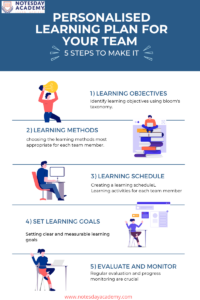How to Create a Personalised Learning Plan for Your Team
The workplace is constantly evolving, and it’s more important than ever to keep up with the latest trends and developments.
One of the best ways to do this is through personalised learning plans, which can help your team stay up-to-date and advance their careers.
This blog post will discuss the steps to creating a personalised learning plan for your team and provide some valuable examples and case studies.
Improved job performance and productivity
 Step 1: Identify Learning Objectives
Step 1: Identify Learning Objectives
The first step in creating a personalised learning plan is to identify the learning objectives for each team member.
This could involve discussions with each team member to better understand their career goals, interests, and aspirations. You could also look at their job descriptions and identify the skills and knowledge required to perform their roles effectively.
Once you have identified each team member’s learning objectives, you can create a personalised learning plan tailored to their specific needs.
Step 2: Choose Learning Methods
After identifying the learning objectives, the next step is choosing the learning methods most appropriate for each team member. This could involve various methods, such as workshops, courses, seminars, e-learning, mentoring, coaching, or on-the-job training. Each team member may have a different preference for learning, so it’s important to offer a variety of methods that suit their learning style.
Step 3: Create a Learning Schedule
Once you’ve identified the learning objectives and chosen the methods, the next step is creating a learning schedule.
This should outline the specific learning activities for each team member, the timeframe for each activity, and any deadlines or milestones.
The schedule should be flexible enough to accommodate changes in priorities, workload, and other factors that may impact the learning plan.
Step 4: Set Learning Goals
Setting clear and measurable learning goals is essential to a personalised learning plan. Each team member should have specific goals aligned with their learning objectives and the organisation’s overall goals.
Goals could be related to acquiring new skills, improving existing skills, or developing competencies required for career advancement.
Ensure the goals are achievable, realistic, and relevant to the team member’s role and career aspirations.
Step 5: Evaluate and Monitor Progress
Regular evaluation and progress monitoring are crucial to ensure that the personalised learning plan is effective and achieves its objectives.
This could involve regular check-ins with team members to review progress, provide feedback, and identify improvement areas.
You could also use performance metrics or other assessment tools to measure the effectiveness of the learning plan and make any necessary adjustments.
Examples and Case Studies:
Here are some examples and case studies of organisations that have successfully implemented personalised learning plans for their teams:
PwC
Professional services firm PwC offers personalised learning plans for all its employees, tailored to their specific career goals and aspirations.
The learning plans are created in collaboration with the employee’s manager and are designed to help them acquire the skills and knowledge needed to advance their careers.
PwC also uses e-learning, virtual classrooms, and other digital tools to deliver learning content to its employees.
AT&T
Telecommunications company AT&T has a comprehensive, personalised learning program called “Vision 2020,” designed to equip its employees with the skills and knowledge needed to keep pace with the rapidly changing industry.
The program includes a variety of learning methods, such as workshops, courses, on-the-job training, and virtual classrooms. The program is customised to meet the specific needs of each employee, and progress is regularly monitored and evaluated.
Southwest Airlines
Airline company Southwest Airlines offers a range of personalised learning programs for its employees, including a leadership development program and a technical operations training program.
These programs are designed to meet the specific needs of each employee and help them acquire the skills and knowledge needed to advance their careers.
The company also offers on-the-job training, mentoring, and opportunities for cross-functional learning.
Amazon
Online retail giant Amazon offers a range of personalised learning programs for its employees, designed to help them acquire the skills and knowledge needed to advance their careers within the company.
The programs include on-the-job training, coaching, mentoring, and e-learning and are customised to meet the specific needs of each employee.
The company also offers a ” Career Choice program,” which provides funding for employees to pursue external education and training programs.
Conclusion
Creating a personalised learning plan for your team can be a valuable investment in their professional development and help them acquire the skills and knowledge needed to advance their careers.
The key steps to creating a personalised learning plan include
- identifying learning objectives,
- choosing learning methods,
- creating a learning schedule,
- setting learning goals, and
- evaluating and monitoring progress.
By following these steps and incorporating some of the best practices from the examples and case studies discussed in this blog post, you can create a personalised learning plan tailored to your team members’ specific needs and goals.
At Notesday Academy, we create specifically curated courses to meet the demands of your organisation, along with meeting the specific needs of your employees.
Click here to speak with a representative from our team and get the best learning and development plan possible for your employees, increase retention and, eventually, your business bottom line.
Follow Notesday Academy
Topic Categories
Get the latest updates
Sign up for our most recent posts
Take out some time to read. No spam, we will email you when a new post is published.




